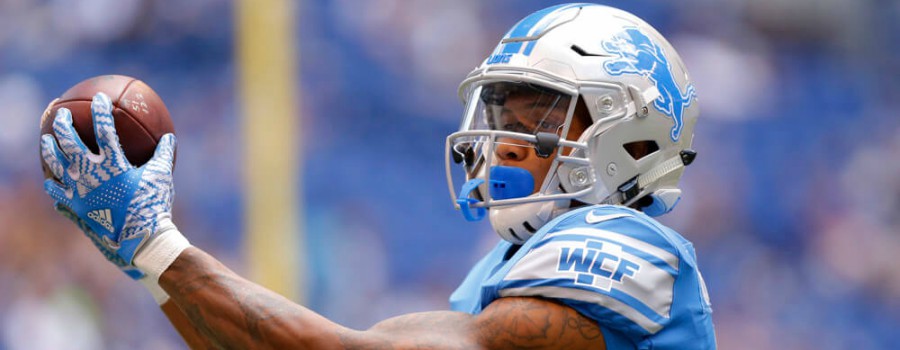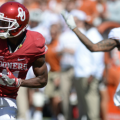Earlier this week I saw the sun blocked out by the moon in a total solar eclipse for the first time in my life. In 2014 rookie wide receivers blocked out veterans and placed two receivers in the top 12 and five receivers in the top 36. Like the eclipse, that may not happen again for a long time, but that doesn’t mean rookies are bad investments. Rookies have immense upside. They win money. Here are five rookie wide receivers to target in DRAFT best ball leagues at their current average draft positions (ADPs).
John Ross (Bengals), 147.6
With his speed (4.22-second 40), Ross is an immediate threat to make an impact in 2017. As a rookie, Ross will be the fastest person on the field in any given play. At a minimum, this gives him touchdown upside on a weekly basis. Ross showed his playmaking ability in college with 1,252 scrimmage yards and 19 all-purpose touchdowns in his final year at Washington. He will have to compete with A.J. Green and Tyler Eifert for targets (10 and 5.9 targets per game last year), but in the best ball format his volatility should outweigh his first-year inconsistency. As a daily fantasy option, he’ll be desirable in guaranteed prize pools: He’ll likely have a low Consistency Rating but also low ownership rate in our Trends tool. This year FantasyLabs users can review ownership trends across guaranteed prize pools of various buy-in levels with our DFS Ownership Dashboard, which is reason enough to subscribe to FantasyLabs. If you want to stack Ross with quarterback Andy Dalton, do it with our Lineup Builder.
For more on Ross, see our Bengals fantasy preview.
Zay Jones (Bills), 168.9
Jones will be used by the Bills out of necessity. The team recently traded former top-10 pick Sammy Watkins and let Marquise Goodwin and Robert Woods walk in free agency. In doing so, they also vacated 2,589 air yards and have to look to new receivers to fill this void. Jones will likely be one of those receivers. Drafted 37th overall, Jones set the single-season NCAA record for receptions with 158 and proved he can handle massive target volume. He’s also a good athlete with solid size (6’2″ and 201 lbs.) and great speed (4.45-second 40) and burst (133.0-inch broad). He wasn’t much of a touchdown producer in college — he never exceeded eight touchdowns in a season — but Jones will have every opportunity to be a fantasy-relevant player from Week 1.
Read more about Jones in our Bills fantasy preview.
Kenny Golladay (Lions), 184.7
With good speed (4.50-second 40) and near-elite size (6’4″ and 218 lbs.), Babytron could emerge as a primary target for the Lions this year. He was a dominant college producer with 1,348 scrimmage yards and 10 touchdowns in his final season at Northern Illinois, and in his three collegiate seasons as the primary receiver on his team he captured an elite 46.0 percent of the receiving touchdowns. He will have to compete for targets with Golden Tate and Marvin Jones, but last year the Lions were 10th in pass plays and third in plays with at least three wide receivers on the field. Even if he’s out-targeted by Tate and Jones, Golladay could still see enough targets to be viable. With his size Golladay has a chance to replace Anquan Boldin as the team’s primary red-zone receiver — Boldin had six red-zone touchdowns last year — and Golladay has already displayed his scoring ability in the preseason with two touchdowns on four targets in Week 1. Even as Golladay’s ADP rises he presents value.
Keep an eye on our NFL News feed to see how the Lions depth chart takes shape and to track any injury updates. For more on Golladay, see our Lions fantasy preview.
Curtis Samuel (Panthers), 212.6
It’s been a bumpy road for Samuel. Since being drafted 40th overall as a 20-year-old early entrant, he’s missed most of the offseason with a hamstring injury and now his ability to establish a role within the Panthers offense is in question. Still, he’s a talented player. In his final college season at Ohio State, he split time between the backfield and the slot amassing 1,636 scrimmage yards and 15 touchdowns on just 171 touches. Among draft-eligible players, Samuel was third in the class with 2.76 yards per route run and fourth with a 53.8 percent breakaway percentage (Pro Football Focus). With his production profile, size (5’11” and 196 lbs.), and speed (4.31-second 40), Samuel is the latter-day Percy Harvin. Although he’s not ticketed for certain touches, Samuel is now healthy and practicing and more than capable of earning touches if Devin Funchess (44.6 percent career catch rate) and Jonathan Stewart (3.8 yards per carry in 2016) continue to underwhelm. A late-round flyer, Samuel has the playmaking capacity to return value at his ADP.
For more on Samuel, see our Panthers fantasy preview.
Chris Godwin (Buccaneers), 216.8
In 2016, Mike Evans proved he can’t carry the Bucs on his own. Although he led the league with 173 targets and had a 1,321-yard, 12-touchdown campaign, his mark of 7.64 yards per target was pedestrian. To give Evans support, the Bucs acquired DeSean Jackson and drafted Godwin in the third round. A strong athlete (4.42-second 40), Godwin has good size (6’1″ and 209 lbs.) and broke out at Penn State at a young age, putting up a 69-reception, 1,101-yard season as a 19-year-old sophomore, which he followed up with a 995-yard, 11-touchdown campaign as a junior. Godwin will have to compete with Evans, Jackson, and even the Bucs tight ends and running backs for targets, but he’s likely to have a few big games this year as a playmaking talent.
You can use our NFL Matchups Dashboard to see Godwin’s best matchups throughout the season. When the season starts, be sure to subscribe to FantasyLabs and do all your daily fantasy research with our Tools and Models.





